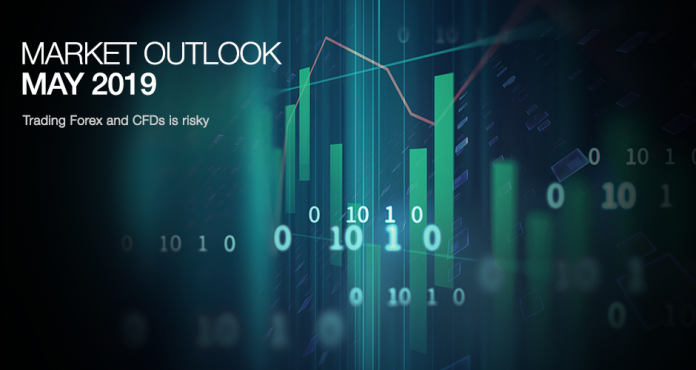Click the button below for a FREE copy of our Monthly insights for May 2019 and get an overview of some of the key events for the month ahead.
CURRENCIES
Dollar: The Dollar started off the month weak but the situation quickly reversed as data releases supported the robust view of the US economy and jobs data continued to hold up. The EURUSD pair averaged lower in April but the decline was less than in March, reaching lows close to 1.11 towards the end of the month. The Fed signaled a continued “wait and see” stance at its meeting this week and that the decline in inflationary pressure was only “transitory”, meaning there was no case for a rate move in either direction. Following the Fed meeting, May has the NFP coming out on the 3rd, PPI data on the 9th, Retail Sales on the 15th, FOMC Minutes on the 15th and closes the month (30) with the key preliminary Q1 GDP numbers.
Euro: Developments in the Euro continued to be less positive than expected with the ECB, after admitting to expectations of lower Euro Area economic growth, being prepared to offer TLTROs to counter them, even if these come as the result of international developments. No progress was made with regards to Brexit, a whole month after the initial deadline, even though the EU appears more prepared for a no-deal Brexit. The Euro is expected to have a month without any policy meetings but packed with political developments, from Brexit discussions to the European Parliament elections on 25-26 of May. Furthermore, 2019Q1 GDP is to be released on May 15.
Sterling: April saw a continuation of the Sterling uptrend as markets absorb the Brexit delay, pushed out to possibly October. The UK Government is now speaking with the main Opposition party to try and agree some consensus but progress is stalled and it’s Brexit that will again dominate the headlines. The next BOE meeting is on May 2nd, with decisions still expected to weigh significantly on Brexit, while preliminary GDP results should be out on May 10.
Yen: The Japanese currency was a loser against the Dollar in April, pivoting around the 111.50 level but capped at 112.00. Trade performance was worse than expected, perhaps due to the global trade tensions, even though inflation remains relatively stable as retail sales decline. Japanese 2019Q1 GDP, out on May 20th, and the Trade Balance, out on the 22nd, are the most important data releases.
Aussie: The Aussie moved down against the Dollar during April despite improved trade balance, positive employment change and better than expected retail sales. The continued worsening of the housing sector and weak inflation numbers pressured the AUD. An interesting RBA meeting is due to take place on May 10, with Employment on the 15th and Parliamentary Elections on the 18th being the other major events.
Loonie: The Loonie continued to decline against the Dollar during April, completing a 3-month fall from the big gain in January. A weak jobs number and a better than expected inflation reading provide mixed messages for the BOC to consider. Trade balance and Employment are to be released on the 7th and 10th of May respectively, while the BOC interest rate meeting is due on the 29th.
Emerging: The Ruble traded below the 65 level against the Dollar, with mostly sideways moves, despite the interest rate differential. The ZAR also lost ground after a strong start to the month as uncertainty regarding the country’s economic outlook continues and with Elections due on May 8. The Turkish Lira moved in tandem, losing ground as the USDTRY touched a 6-month high over 5.95. In contrast, the Mexican Peso gained significantly as USDMXN moved down from 19.35 to 18.95.
COMMODITIES
Gold: Gold peaked at $1311 on April 10 but has since declined under the key $1285 support zone and traded as low as $1266. The risk-on equity rally, strong Q1 earnings and the easing of trade tensions have undermined gold bulls during April. Support now sits at the $1265-55 zone. The central bank shift to stable interest rates should, in the longer term, provide some support for the Gold price.
Silver: The price of Silver also had a negative April and completed a 3-month move to the downside from February highs at $16.16, to April lows of $14.75. Weakening PMIs will reduce the industrial demand for Silver and could track Gold’s path lower. However, it could be up for a volatile year if global uncertainties ease.
Oil: Oil continued its upwards trend in April and completed a four-month rally, ending the month around the $63.50 mark but down from a high of $66.50. Still, prices remain volatile as they continue to fluctuate as demand and supply are still quite unpredictable: US Oil inventories pivot from build to drawdown conditions from week to week. The situation in Libya and the ongoing crisis in Venezuela helped push prices higher. Finally, the US reprieve on Iranian Oil imports for a handful of countries, expired on May 1 and will be a key theme in the coming month.
INDICES
US: The US markets (USA30, USA100, and USA500) moved positively again in April, and to new all-time highs. Despite the ongoing trade tensions, there were positive tones from the ongoing discussions, and Q1 earnings were overall strong and better than expected. The reduction in corporate profits has not been as serious as expected, though if the slowdown continues market growth could be lower than expected. The “wait and see” stance from the Fed aided in boosting market sentiment, as dovish comments along with delayed rate hikes should also be beneficial to the economy. The unexpected increase in Q4 GDP to 2.6%, compared to expectations of 2.2%, shows that the US economy is still resilient even though this confirms the slowdown in growth, as Q3 growth stood at 3.4%. Q1 data on May 30 will be key.
Europe: Stock markets in continental Europe moved in tandem with the US exchanges, as the GER30 and FRA40 continued their rise, despite mixed economic data releases and weak PMI data in particular. The UK100 also moved up during April, even as Sterling appreciated and the Brexit deadline was extended again. The UK stock markets have proved remarkably resistant to all the Brexit uncertainty.
Japan: The JPY225 moved inversely to the Yen and continued its uptrend, in conjunction with the overall trend in Europe and the US. The Japanese economy has underperformed over the past month, however the overall economic outlook is positive for the country as inflation continues to remain above zero and spending and loans growth remain positive. The macro environment could also benefit from a relaxation of trade tensions.
EQUITY PICK OF THE MONTH – NETFLIX
Probably the world’s leading media streaming company, Netflix saw its earnings per share and sales beat analyst estimates but, following the company’s guidance about fewer than expected new subscribers, its shares dropped 9% just hours after the publication of the Q1 report. In the guidance, CEO Reed Hastings commented that the US price increase contributed to that, even though he commented that he wasn’t concerned about new rival streaming services. The company had earlier commented that the video streaming market is large enough to accommodate Disney+, Apple TV+ and Netflix.
In general, Netflix is expecting approximately 5 million new subscribers, compared to forecasts of 5.4 million, even though the increase in pricing is likely to increase its income. Even though subscribers are price-sensitive, it appears unlikely that the one Dollar increase in the monthly fees could have a material impact. It is more likely that the Disney+ platform, which should come at a much lower rate, at $7 per month, could take some market share from Netflix, even though it is still unknown whether the new venture will be profitable at such low rates. The month of May should provide an interesting pivot point for Netflix shares, as they have been trading at about a 132 P/E ratio, following a downwards trend since December 2015, where a 402 P/E ratio was observed. The big question traders have to answer is whether the Disney+ threat is important and if so, whether that P/E ratio is also doomed to decline.
CRYPTOS
Bitcoin ended the month close to the $5500 mark, after a significant breakout in early April. April 2 and 3 prices gapped north on stories of April Fool’s day buying and significant purchases concentrated at three major exchanges. The price broke over the key 200-day moving average for the first time in eleven months on April 18 and has to date held this important zone and the psychological $5000 level. Ethereum tracked Bitcoin higher in early April but moved significantly lower in the final week and registered only modest gains for the month, closing under $160.00. Ripple’s price was little affected by the Bitcoin movements, with its price rising to $0.3069, up from $0.3043.
Stuart Cowell
Head Market Analyst
Disclaimer: This material is provided as a general marketing communication for information purposes only and does not constitute an independent investment research. Nothing in this communication contains, or should be considered as containing, an investment advice or an investment recommendation or a solicitation for the purpose of buying or selling of any financial instrument. All information provided is gathered from reputable sources and any information containing an indication of past performance is not a guarantee or reliable indicator of future performance. Users acknowledge that any investment in FX and CFDs products is characterized by a certain degree of uncertainty and that any investment of this nature involves a high level of risk for which the users are solely responsible and liable. We assume no liability for any loss arising from any investment made based on the information provided in this communication. This communication must not be reproduced or further distributed without our prior written permission.



















